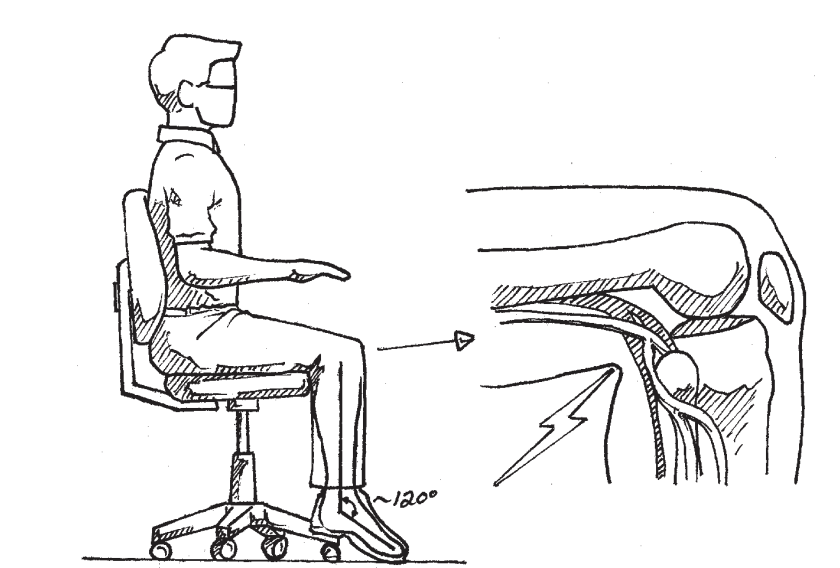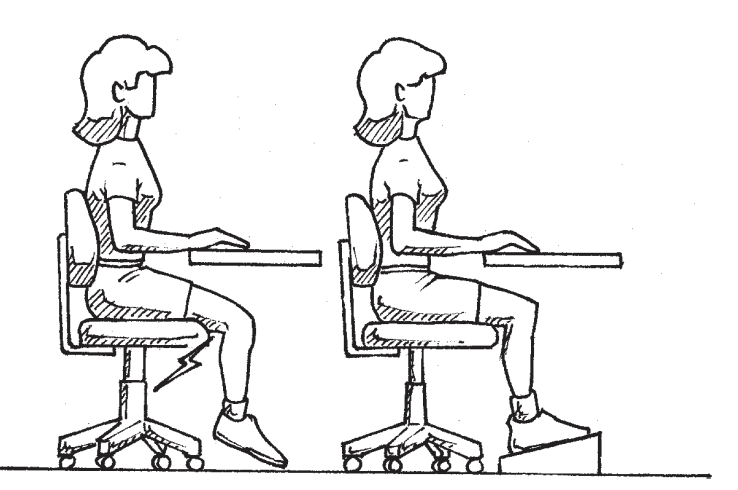How To Sit With Good Form
Good Posture
Good posture not only improves the way you look and feel, it keeps your muscles in balance and your body well aligned allowing optimal efficiency of all your body systems.
Poor posture places abnormal weights on joints and stresses muscles and tendons, often leading to pain.
Posture is highly influenced by the environment and the activities we place ourselves in for the most amount of time.
For example, someone who is seated for 10 hours a day is going to present with specific postural patterns that are relevant to the act of sitting for a large volume of hours per day. The purpose of this quick article is to show you how to set up your ergonomics using principles that allow you to sit with good form.

Chair Height
When your chair is too high, the space behind your knee (the popliteal fossae) becomes compressed. This frequently causes numbness in the lower leg and slows circulation to and from the lower leg, resulting in swollen feet.

When your chair is too low, the large nerve structure called the “sciatic” nerve of- ten gets compressed. This leads to pain in the low back and legs and can result in numbness in one or both legs.

When your chair fits correctly, there is a 90° angle at the knee and there is no discomfort behind the knee or in the butt region. The feet should always rest flat on the floor unless you are using a footrest. If for any reason you do place a footrest under your feet, always readjust your chair, keyboard, and video display unit height to maintain optimal working relationships.

Using a foot rest
If you are short, and your working surface is high enough that you can’t keep your feet on the ground without excessive pressure on the backs of your legs, it will be necessary to use a foot rest.
To determine the height of your footrest, adjust your chair height until your arms are comfortably placed on the table and your elbow is bent to 90°. Once your arms are at the correct height, measure how high your footrest will have to be.

Using Lumbar support
When using a chair with an adjustable lumbar support, it is important to position it correctly. The apex of your lumbar curve is directly behind your belly button. Adjust your lumbar support so that the most convex point of the lumbar support is directly behind your belly button.

Keyboard Height
Because the keyboard height is fixed in most desks, it is critical that you adjust your chair to allow your forearms to be parallel to the floor when you hands are in a comfortable typing position and you are sitting in good upright posture. Have a look at these 4 different seated postures. A is top left, B top right, C bottom left, D bottom right:

A. When an individual is set-up correctly for writing at a desk with a keyboard the feet are supported as needed and the shoulders remain relaxed, allowing good ergonomics while writing.
B. If a writing desk is used for typing, or if a short person attempts to use a writing desk for extended periods with too low a seat height, the shoulders will be held in an elevated position to accommodate optimal working relationships for the hand. This results in chronic loading of the shoulder girdle elevator muscles, commonly leading to tension headache and chronic soft tissue disfunction.
C. When the shoulder elevators become chronically fatigued, an abducted arm position is commonly adopted. This leads to rapid fatigue of the arm abductor and shoulder girdle elevator muscles because the large deltoid muscles are not suited to postural loading; they are best suited for movement.
D. In some cases, poor ergonomic set-up at the keyboard results in a combined adaptation, integrating elevation of the shoulder girdle and abduction of the arm. The result is the same, pain and chronic discomfort leading to decreased work performance in a very short time!
Using a Swiss Ball
I commonly recommend using a Swiss Ball as a chair because the Swiss Ball allows free mobility of the lumbar spine. This is very helpful to the lumbar discs because the mobility afforded by sitting on a Swiss Ball improves fluid and nutrition delivery to the discs of the lumbar spine, which may reduce the incidence of degenerative disc disease. Using the Swiss Ball as a chair also improves overall blood flow because it keeps the muscles of the legs and torso active. Many people feel they do well when alternating between their traditional desk chair and a Swiss Ball for periods of about thirty minutes throughout the day.
Screen Height
By setting your screen height so that you are looking directly into the centre of the screen, you are more likely to maintain optimal posture throughout the day because your eyes dictate posture. If your eyes are focused below the centre point most of the day, the tendency is to be drawn into flexion or forward. When your screen is set-up correctly, your eyes will wonder above and below the mid-point, which will encourage better postural alignment, improve blood flow to the head and improve productivity.

Illustrations courtesy of the C.H.E.K. Institute, 609 South Vulcan Avenue, Suite 101, Encinitas, CA 92024, USA

Want to learn about my Integrated Health & Corrective Exercise Kinesiology program?
This in-person program works to uncover any postural distortions, increase freedom of movement, stimulate the body to regain its balanced state, as well as develop a highly functional body that looks and feel great.
Pierre Higginson is a CHEK Practitioner, Corrective Exercise Specialist, and Nutrition & Lifestyle Coach based out of Ealing Fitness Clinic, West London.